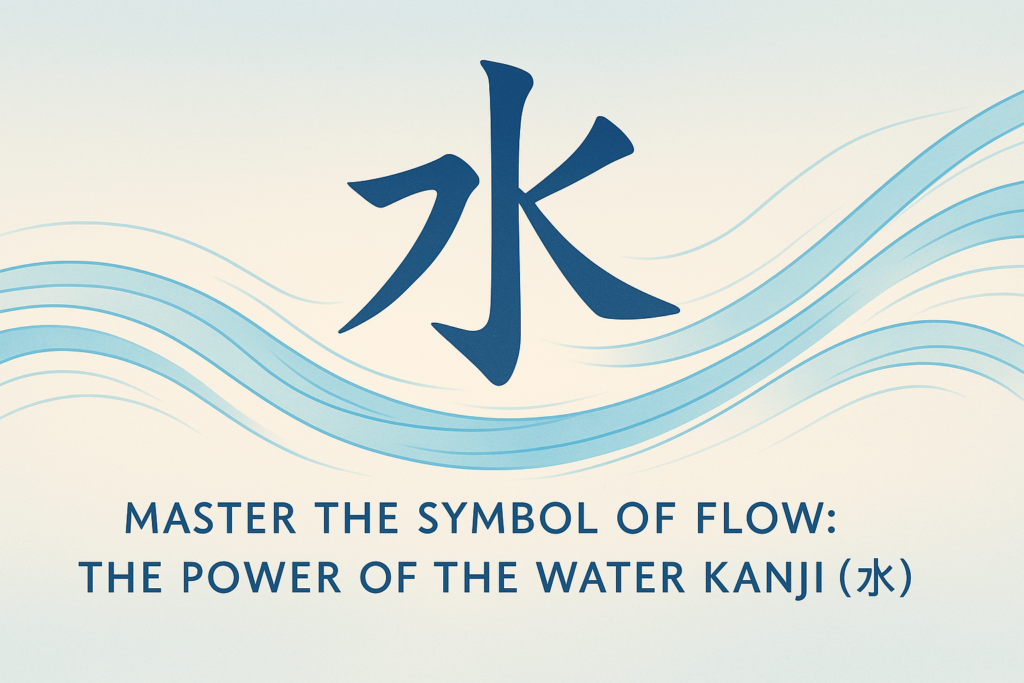Have you ever been captivated by the elegant simplicity of Japanese kanji? Among the first characters that Japanese learners encounter is the water kanji (水), a fundamental symbol representing one of nature’s most powerful elements. This character not only serves as a building block for hundreds of other kanji but also carries deep cultural significance that extends beyond its literal meaning.
The Essence of Water Kanji: 水 (Mizu)
The water kanji, written as 水 and pronounced “mizu” in Japanese (みず) or “sui” (スイ) in its Chinese-derived reading, is one of the most recognizable and frequently used characters in the Japanese writing system. As a Grade 1 kanji taught to Japanese schoolchildren, it’s considered essential knowledge for anyone beginning their Japanese language journey.
With just four simple strokes, this kanji beautifully captures the essence of water’s flowing nature:
- A vertical line down the center
- A horizontal stroke crossing near the top
- A diagonal stroke from top-left to bottom-right
- A diagonal stroke from top-right to bottom-left
The visual representation evokes the image of water flowing through narrow passages and spreading out again—perfectly embodying water’s adaptable nature.
Origins and Evolution of the Water Kanji
Like many kanji, 水 originated as a pictograph in ancient China. The earliest forms depicted flowing water with a central stream and branching tributaries. Over centuries, this pictorial representation was simplified to the form we recognize today.
The evolution of this character reveals how our ancestors observed and interpreted natural phenomena, creating visual symbols that captured essential characteristics. In the case of water, they recognized its ability to:
- Flow freely through constraints
- Change shape according to its container
- Branch into multiple streams
- Return to a unified form
This understanding of water’s fundamental properties became encoded in the very structure of the kanji itself.
Want to explore Japan’s culture?
Discover Japan’s rich culture, traditions, and hidden gems with our expertly crafted guides. Get insider tips on travel, food, and history. All for free!
How to Remember the Water Kanji
Creating a mental image can significantly help in remembering this kanji. Picture a wide stream of water encountering a narrow passage—the water compresses to flow through and then spreads out again on the other side. This visualization mirrors the kanji’s shape and helps connect the symbol to its meaning.
Unlike more complex kanji that might require elaborate memory techniques, 水’s relatively simple form makes it easier to learn. Its frequency in everyday Japanese writing also provides plenty of opportunities for reinforcement.
Stroke Order: The Proper Way to Write 水
In Japanese calligraphy and writing instruction, stroke order is crucial. For the water kanji, follow these steps:
- Draw the central vertical line from top to bottom
- Add the horizontal line crossing near the top
- Draw the diagonal stroke from upper left to lower right
- Finally, add the diagonal stroke from upper right to lower left
Practicing this stroke order helps develop muscle memory and ensures your writing looks balanced and properly proportioned.
Water Kanji as a Building Block: The Radical Form
One of the most fascinating aspects of 水 is its role as a radical (component) in numerous other kanji. When used as a building block, it typically transforms into the form 氵, called “sanzui” in Japanese. This three-drop water radical appears in over 100 kanji characters, including:
- 海 (うみ, umi): sea, ocean
- 泳 (およぐ, oyogu): to swim
- 洗 (あらう, arau): to wash
- 波 (なみ, nami): wave
- 湖 (みずうみ, mizuumi): lake
This pattern demonstrates how Japanese uses the water radical to create a semantic network of water-related concepts. When you spot the 氵 component in an unfamiliar kanji, you can often guess that its meaning relates to liquids or fluidity.
Cultural Significance and Symbolism
In Japanese culture, water (水) carries profound symbolic significance beyond its practical uses. It represents:
- Purity and cleansing (as seen in Shinto purification rituals)
- Adaptability and resilience
- Tranquility and calm
- The continuous flow of life and time
Japanese proverbs frequently reference water to convey wisdom about life’s challenges. For example, “流れる水は腐らず” (Nagareru mizu wa kusarazu) means “Flowing water doesn’t stagnate,” suggesting that people should keep moving forward rather than becoming stuck in one place.
If you’re interested in how Japanese uses other natural elements in expressions, check out our Japanese Onomatopoeia List, which includes many water-related sound words.
Common Words and Phrases Using 水
The water kanji appears in numerous everyday Japanese words. Here are some essential vocabulary items featuring 水:
- 水曜日 (すいようび, suiyoubi): Wednesday
- 水中 (すいちゅう, suichuu): underwater
- 水泳 (すいえい, suiei): swimming
- 水道 (すいどう, suidou): water supply
- 水分 (すいぶん, suibun): moisture
- 水色 (みずいろ, mizuiro): light blue (the color of water)
Understanding these compounds enhances your Japanese vocabulary while reinforcing your recognition of the water kanji. To learn more about how Japanese expresses time concepts, including days of the week like 水曜日, explore our article on Japanese Future Tense.
Practice Tips for Mastering the Water Kanji
To fully integrate this kanji into your Japanese writing repertoire:
- Practice writing it daily following the correct stroke order
- Create flashcards with common words containing 水
- Look for the water radical in new kanji you encounter
- Use the mnemonic visualization of water flowing through passages
- Try incorporating it into short sentences
For comprehensive Japanese learning resources, including more kanji guides, visit our Learn Japanese page where you can access free guides to accelerate your language journey.
Q&A About Water Kanji
Q: How many strokes are in the water kanji (水)? A: The water kanji consists of 4 strokes.
Q: What is the Japanese pronunciation of 水? A: In Japanese, 水 is pronounced “mizu” (みず) in its native reading and “sui” (スイ) in its Chinese-derived reading.
Q: When do Japanese students learn the water kanji? A: Japanese schoolchildren learn 水 in the first grade as part of the essential kanji curriculum.
Q: How is the water kanji used as a component in other characters? A: When used as a component, 水 typically appears as the three-drop radical 氵(sanzui) on the left side of more complex kanji.
Q: What color is associated with 水 in Japanese? A: The color 水色 (mizuiro), a light blue shade, is directly associated with water in Japanese color terminology.
Conclusion
The water kanji (水) embodies the essence of flow and adaptability in Japanese writing. With its simple yet meaningful form, it provides valuable insights into how pictographic writing systems evolved and how language encodes our understanding of natural elements.
By mastering this fundamental character, you’ve taken an important step in your Japanese language journey. The skills and knowledge you gain from learning 水 will serve as a foundation as you continue to explore the fascinating world of Japanese kanji.
Remember that like water itself, language learning flows best when approached with flexibility and persistence. Keep practicing, stay curious, and watch your Japanese skills grow naturally over time.
Love Japan? Stay in the Loop!
Get the best of Japan straight to your inbox: language, culture & travel insights!




